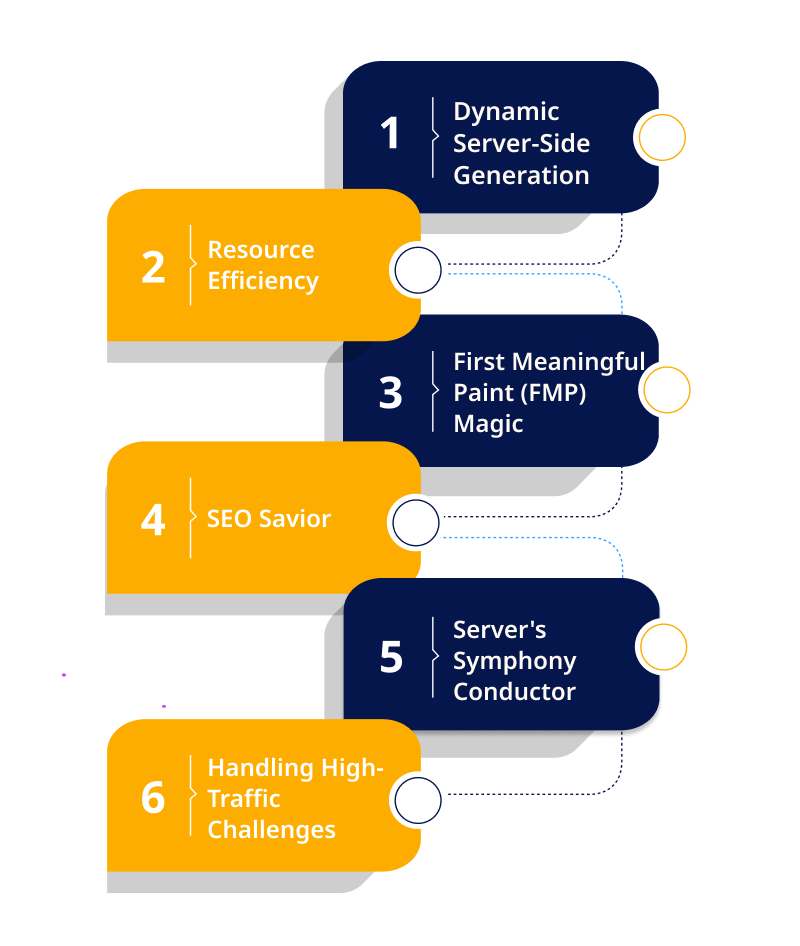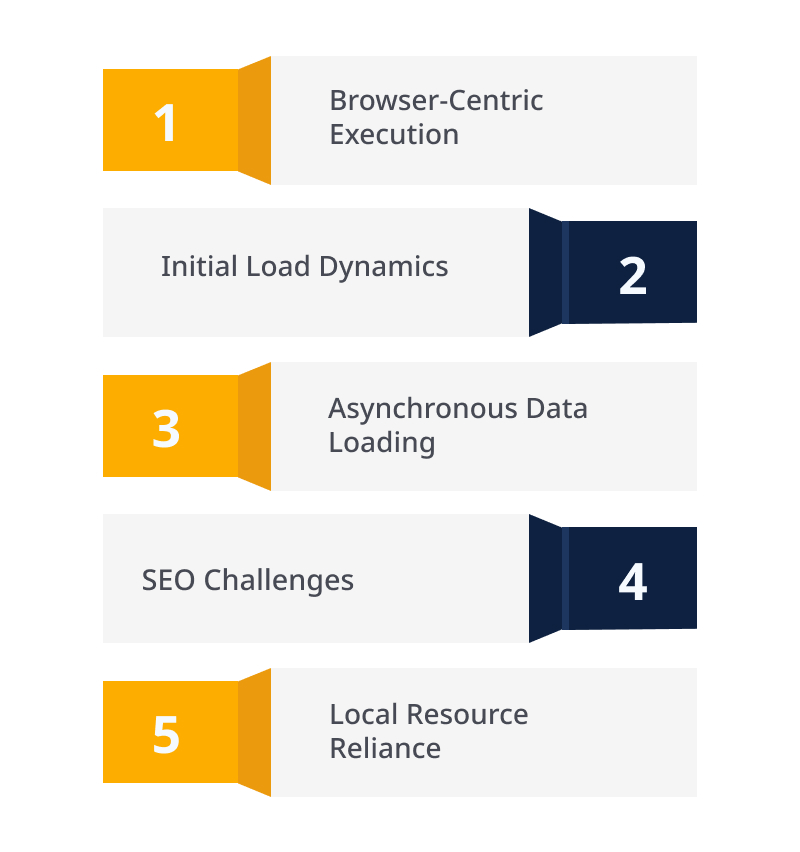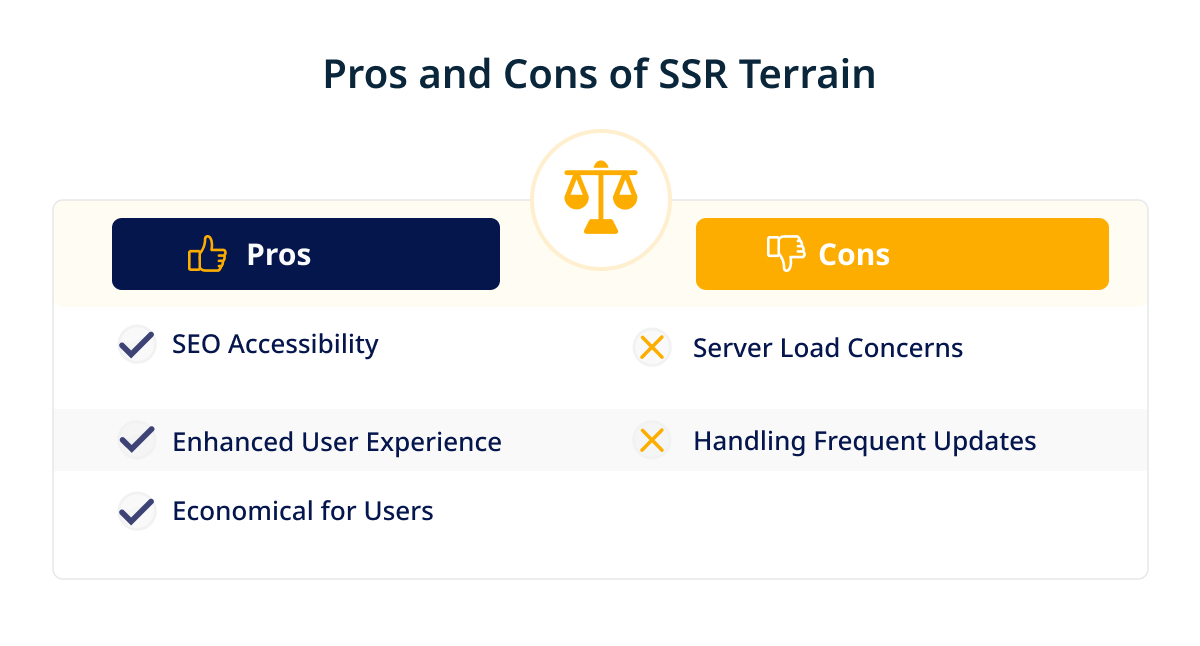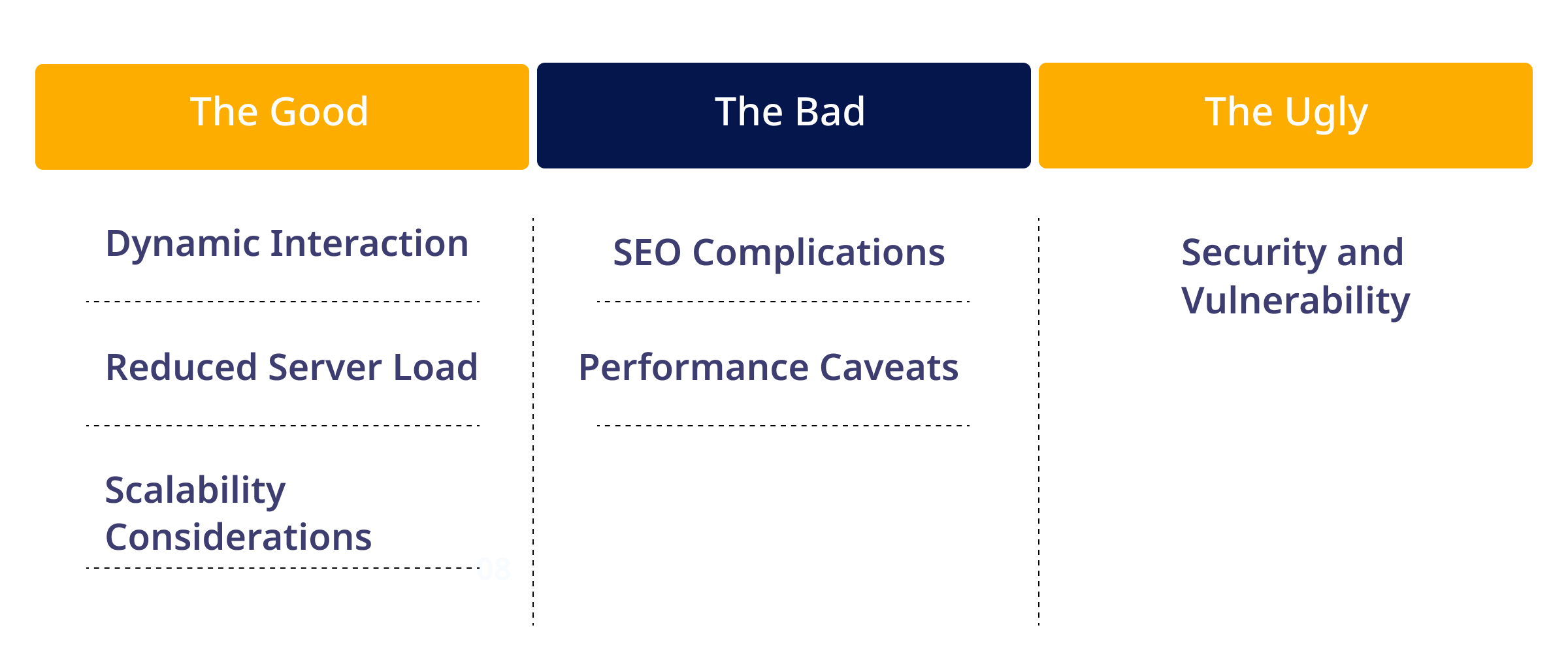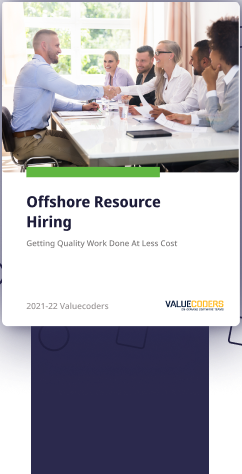Quick Overview
This blog post provides an overview of server-side and client-side rendering approaches in web development, contrasting how each method impacts site interactivity and performance. It explores the mechanics behind both, evaluates the pros and cons of each through concepts like isomorphic JavaScript, and discusses popular frameworks that combine these rendering techniques.
When building a website, developers must decide whether the bulk of the work should fall on the server or the user’s browser (client). This choice between server-side rendering (SSR) and client-side rendering (CSR) impacts site speed, interactivity, and overall user experience.
With CSR, the initial HTML the server sends is minimal – just enough to load the page skeleton. All rendering happens in the browser as JavaScript executes, updating page sections dynamically without full reloads.
The benefits? Faster perceived performance and seamless interactivity. Facebook and Google leverage CSR to enable the snappy single-page applications we know well.
However, CSR isn’t always ideal. The initial minimal HTML is essentially useless for search engines. Some argue CSR bloats browser responsibility. And JavaScript reliance risks inconsistencies across devices. SSR addresses these concerns by building total HTML pages on the server before delivering them to the client.
So, which approach reigns supreme?
As with many coding dilemmas, the answer lies somewhere in between. We’ll explore the mechanics and tradeoffs of both client-side and server-side rendering benefits to help you decide what works best.
Enhancing User Experience Through Rendering Strategies
The rendering quality – translating a website’s design code into a visual display – directly impacts user experience (UX). Rendering speed and approach influence site interactivity and engagement.
- Fast rendering times increase user engagement. Mobile users abandon 53% of sites if pages take >3 seconds to load. Swift rendering keeps visitors interested.
- Developers use server-side rendering (SSR), client-side rendering (CSR), or a hybrid universal/isomorphic approach to optimize performance. Each impact:
- SEO optimization
- Initial load times
- Interactivity speed
- Scalability
- Maintainability
- SSR sends fully populated HTML from the server, allowing immediate page views but slower interactions until JavaScript loads.
- CSR offers faster interactions by running JavaScript in the browser but slower initial loads due to empty HTML sent while waiting for JavaScript execution.
Unlock the potential of lightning-fast rendering with ValueCoders.
Incorporating progressive web apps can optimize both SSR and CSR by enabling sites to function more like native apps. This improves UX by
- Offering offline use
- Performance despite network conditions
- Driving customer retention
Optimizing client-side rendering vs. server-side rendering and overall web development rendering techniques improves user experience, driving engagement and business success. Reach out to our backend development services team to discuss options.
Also Read: 20+ Top Web Development Frameworks (Updated List 2024)
The Power of Server-Side Rendering (SSR)
Ever wondered how web pages swiftly materialize before your eyes upon clicking a link?
Enter Server-Side Rendering (SSR), a crucial component in creating seamless user experiences.
Let’s dissect the essence of SSR and its impact on the digital realm.
- Dynamic Server-Side Generation: SSR involves creating fully rendered HTML pages on servers before delivering them to end-user browsers with each page request.
- Resource Efficiency: Contrary to assumptions, SSR frameworks efficiently balance actions between clients and servers, reducing the strain on servers, which is particularly beneficial for slower internet connections.
- First Meaningful Paint (FMP) Magic: SSR shines in FMP timings, ensuring critical content appears swiftly upon loading, captivating users instantly and minimizing bounce rates.
- SEO Savior: Unlike Client-Side Rendering (CSR), SSR caters to search engine bots, enhancing SEO by allowing efficient content retrieval for indexing.
- Server’s Symphony Conductor: Consider Server-Side Rendering (SSR) as the conductor orchestrating a harmonious ensemble of website elements. It processes rendering solutions on servers, delivering pre-processed pages for users.
- Handling High-Traffic Challenges: While serving a small user base is manageable, SSR tackles scalability challenges, crucial for high-traffic platforms experiencing millions of daily users.
Adopting SSR isn’t merely a technical choice—it’s a strategic move for businesses aspiring to deliver prompt, engaging user experiences.
Stay tuned for more insights on the client-side vs. server-side rendering debate and discover how SSR stands as a cornerstone in the digital performance landscape. For expert guidance, consider the option to hire backend developers versed in SSR intricacies.
The Intricacies of Client-Side Rendering (CSR)
In web development, Client-Side Rendering (CSR) stands out as a powerful strategy, revered for its ability to deliver immersive and responsive user experiences.
Harness the power of client-side rendering for dynamic user experiences.
Let’s dissect the mechanics of CSR, delving into the core elements that make it a go-to approach for many developers.
- Browser-Centric Execution: CSR centers its operations within the user’s browser, starkly contrasting with server-side processes. The computational heavy-lifting occurs locally, powered by renowned open-source JavaScript frameworks like Chrome’s V8 or Firefox’s Spidermonkey.
- Initial Load Dynamics: CSR entails a significant initial load cost compared to server-rendered counterparts, necessitating the download of additional assets, including a single JavaScript file. However, this cost is a one-time affair. Subsequent interactions benefit from cached information, delivering a seamless browsing experience.
- Asynchronous Data Loading: With CSR, data fetching unfolds post-initial JavaScript downloads through APIs. This enables asynchronous loading, empowering updates on specific page components without needing entire page reloads—an evolution in web development practices.
- SEO Challenges: Historically, CSR faced SEO challenges due to search engine limitations in interpreting JavaScript. However, advancements have alleviated these concerns, including reusable UI components and Googlebot’s improved capabilities. Although not flawless, modern solutions offer improved SEO compatibility.
- Local Resource Reliance: CSR heavily relies on local resources, leveraging users’ browsers. This makes it ideal for web applications demanding constant interactions, such as real-time updates, animations, and scenarios like single-page applications (SPAs), analytics sites with post-first-render analytics, and feature-rich e-commerce platforms.
Understanding the complexities of CSR is crucial for developers navigating the client-side vs. server-side rendering landscape. Stay tuned for more insights on front-end rendering, back-end rendering, and their roles in shaping the digital realm.
Consider exploring professional website development services aligned with evolving rendering strategies for expert guidance.
Also Read: Top 9 Web Development Companies Catering To Global Clients
Navigating the SSR Terrain: Pros and Cons Unveiled
Going for the SSR vs. CSR debate in web development is like navigating a labyrinth. Let’s understand the intricacies of Server-Side Rendering (SSR) to reveal its distinct advantages and drawbacks, aiding you in choosing the optimal approach for your needs.
Pros
- SEO Accessibility: SSR gains a significant edge by offering excellent accessibility for search engine crawlers. Googlebot or Bingbot can swiftly index fully rendered pages from the server, enhancing SEO performance.
- Enhanced User Experience: SSR shields users from the agony of staring at blank screens during loading, a common pitfall in Client-Side Rendering (CSR). Achieving “the first contentful paint” faster ensures a quicker and more engaging user experience.
- Economical for Users: SSR distributes heavy-lifting operations on the server side, ensuring a fair user experience across devices, especially for users with low-end devices or subpar internet connectivity.
Cons
- Server Load Concerns: SSR can impose additional pressure on servers, impacting loading speeds and costs. While cloud-based services can dynamically scale, careful consideration of cost structures is imperative.
- Handling Frequent Updates: Websites requiring continuous dynamic updates may face challenges in an SSR environment. Each interaction demands a new HTML fetch, potentially hindering smooth real-time interactivity on platforms like live auctions or fantasy sports applications.
While SSR boasts undeniable benefits, understanding its potential downsides is crucial. Stay tuned for more insights into the client-side vs. server-side rendering landscape, and explore tailored solutions through professional custom application development services.
Say goodbye to page reloads with CSR expertise from ValueCoders.
Client-Side Rendering: Unveiling Layers of Dynamics
While going for the process of client-side rendering, advantages in web development show various attributes, ranging from enticing benefits to potential pitfalls. Let’s dissect CSR’s good, bad, and ugly facets, shedding light on its dynamic nature.
The Good
- Dynamic Interaction: CSR excels in providing dynamic user interaction by processing event-based actions swiftly within the user’s browser. This translates to a seamless and fluid browsing experience for visitors.
- Reduced Server Load: Unloading computational tasks onto clients’ devices alleviates server load, potentially reducing operational costs associated with maintaining high-performance servers.
- Scalability Considerations: Shifting computations to clients’ browsers reduces dependency on servers for rendering, addressing scalability challenges during peak visitation periods and potentially leading to cost savings.
The Bad
- SEO Complications: Not all search engine crawlers adeptly index sites built around complex JavaScript structures typical in CSR. This may compromise web page visibility, impacting organic discovery rates.
- Performance Caveats: While initial loading speeds can be faster, the total time required for a fully interactive webpage to render may face challenges. Factors like network conditions and user computation capabilities can impact post-initial-load content updates.
The Ugly
- Security and Vulnerability: Entrusting clients with extensive management can pose cybersecurity risks. While proper development practices can mitigate these concerns, unintentional mistakes or library data-sharing vulnerabilities may expose sensitive information.
Understanding the nuances of CSR is pivotal for informed decision-making in the client-side vs. server-side rendering landscape. Stay tuned for deeper insights into rendering optimization in web development and explore tailored solutions through professional custom web app development services.
Unlocking the Power of Isomorphic JavaScript: The Bridge Between SSR and CSR
Solving the intricacies of web development introduces us to Isomorphic JavaScript. This technique seamlessly merges the strengths of Server-Side Rendering (SSR) and Client-Side Rendering (CSR).
Let’s understand the essence of Isomorphic JavaScript and why it’s considered a bridge between speed and interactivity.
Isomorphic JavaScript, or universal rendering, creates a synergy between SSR and CSR. The initial page rendering occurs on the server, followed by sending a compact JavaScript file to the browser for completion.
This unique approach blends SSR’s speed advantages with CSR’s interactivity benefits. Here are some advantages of universal Rendering:
- Faster Initial Load Times: The server renders the page before transmitting it to the browser, facilitating instant loading for users.
- Improved SEO: SSR pages are more search engine-friendly, enhancing the website’s search ranking.
- Enhanced Interactivity: The browser can update the page without reloading the entire content, elevating user experience.
- Flexibility in Framework Usage: Any JavaScript framework can be employed for rendering on the server and in the browser.
Drawbacks of Universal Rendering:
- Increased Implementation Complexity: Universal rendering is more intricate than standalone SSR or CSR.
- Potential Slower Subsequent Page Loads: After the initial load, subsequent page loads might be slower than CSR due to downloading the JavaScript file from the server.
Isomorphic JavaScript in Action
Examples of websites leveraging universal rendering include:
- Google Search: Ensuring quick loading of search results for users with slow internet connections.
- Twitter: Facilitating instant loading of tweets for users.
- Medium: Providing a smooth and interactive reading experience.
Considerations for Implementation
- Optimize Server Speed: A fast server is crucial for rendering pages quickly, ensuring instant loading.
- Choose a Performance-Optimized Framework: Select a JavaScript framework optimized for superior performance.
- Thorough Testing: Rigorously test your website with universal rendering before deploying it to production.
Isomorphic JavaScript proves to be a compelling choice for websites desiring a blend of speed and SEO-friendliness. If you are ready to invest the extra effort, this technique can offer you the best of both worlds.
Consider consulting with a leading top .NET development company in India for tailored web development solutions.
Experience the best of both worlds with Isomorphic JavaScript.
Example Frameworks for Universal Rendering
Popular frameworks enable universal rendering for optimized web apps:
- ReactJS: Pioneer of component-based architecture. Server-side rendering boosts performance and SEO. Virtual DOM enables efficient rendering updates. Focuses on reusable components for faster development.
- NextJS: Flexible and well-documented. Automatic code-splitting enables faster page loads to improve user engagement.
- Svelte: Compiles code into modules at build time rather than interpreting at runtime, providing speed advantages.
- Fresh: Minimalist framework built for TypeScript and Deno runtime. Newcomer with potential for future growth.
Key advantages of these universal rendering frameworks:
- Faster page loads and rendering updates
- Improved SEO capabilities
- Reusable components streamline development
- Boosted user engagement metrics
Modern frameworks like React, Next, and Svelte optimize client-side and server-side rendering apps, enhancing performance through efficient updates, code-splitting, and ahead-of-time compilation.
Final Thoughts
When it comes to client-side vs. server-side rendering, the answer is rarely black or white. Both approaches have merits depending on the goals and scale of a project.
- SSR offers lightning-fast first paints and built-in SEO optimization. However, complex sites can tax servers and budgets.
- CSR delivers unmatched interactivity and scalability once loaded. Yet slow initial renders may bounce impatient visitors.
The good news? Modern universal rendering frameworks like React and Next.js give developers the best of both worlds. Real-world strategies like code-splitting, CDNs, and caching aim to mask the downsides of each method.
So rather than decide on the rendering approach in a vacuum, let context and priorities guide architecture decisions. Want to boost SEO and sales on an e-commerce site? SSR may be the ticket. Building a web app valued for user experience over discoverability? CSR likely makes more sense.
The first step is asking the right questions. Our engineering team is happy to help your business determine optimal rendering strategies for your next web project. Contact us today to get the conversation started.



